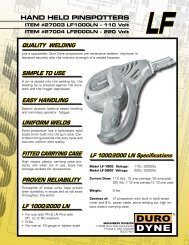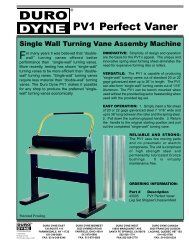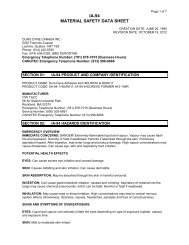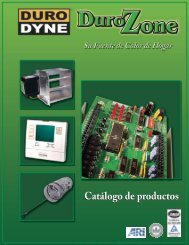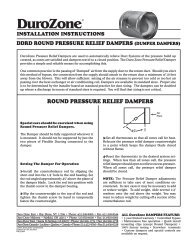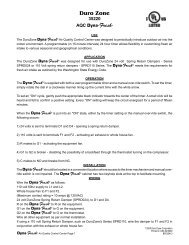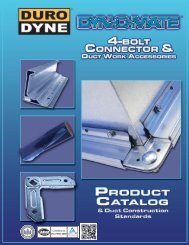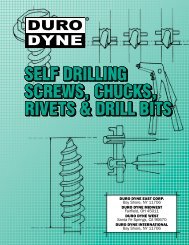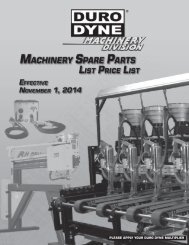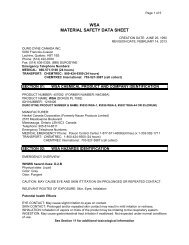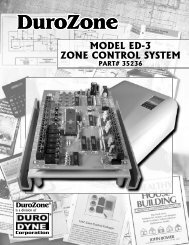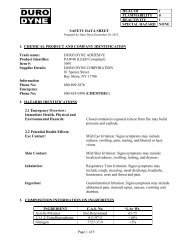Create successful ePaper yourself
Turn your PDF publications into a flip-book with our unique Google optimized e-Paper software.
<strong><strong>Duro</strong>Zone</strong><br />
®<br />
MODEL SMZ4-SW<br />
ZONE CONTROL SYSTEM<br />
<strong><strong>Duro</strong>Zone</strong> ®<br />
is a division of<br />
®<br />
Corporation<br />
PART# 35228
SMZ4-SW INSTALLATION INSTRUCTIONS<br />
Congratulations on purchasing a <strong>Duro</strong> Zone SMZ Control<br />
System. The SMZ Panel together with <strong>Duro</strong> Zone Multiline<br />
Dampers will provide year round comfort for your customer.<br />
Following are simple step-by-step installation instructions and<br />
wiring diagrams for the SMZ System.<br />
For your convenience, your SMZ System is shipped “knocked<br />
down”. Do not mount circuit board to box before attaching<br />
box to wall or the mounting holes will be inaccessible.<br />
1 - Mount the panel box to any flat surface.<br />
2 - Mount the circuit board to the panel box with the<br />
nylon standoffs provided.<br />
3 - Strip the wires and attach them to their respective<br />
terminals.<br />
4 - Snap the cover onto the panel box.<br />
ZONE 1<br />
The lower left terminal strip is for Zone 1. The Zone 1<br />
Thermostat must have a heat/cool fan on/auto switchable<br />
sub-base with B & O Terminals. <strong>Duro</strong> Zone’s MSSB Sub-<br />
Base, Part #35214, with a <strong>Duro</strong> Zone 3WT Thermostat,<br />
Part #35052, is recommended.<br />
FROM TOP TO BOTTOM:<br />
SMZ Terminal “R” goes to “R” on Zone 1 Thermostat.<br />
SMZ Terminal “B” goes to “B” on Zone 1 Thermostat.<br />
SMZ Terminal “O” goes to “O” on Zone 1 Thermostat.<br />
SMZ Terminal “W” goes to “W” on Zone 1 Thermostat.<br />
SMZ Terminal “Y” goes to “Y” on Zone 1 Thermostat.<br />
SMZ Terminal “G” goes to “G” on Zone 1 Thermostat.<br />
SMZ Terminal 1 goes to Terminal 1 of Zone 1 Damper Motor.<br />
SMZ Terminal 2 goes to Terminal 2 of Zone 1 Damper Motor.<br />
SMZ Terminal 4 goes to Terminal 4 of Zone 1 Damper Motor.<br />
SMZ4-SW OPERATION<br />
The SMZ is a simple zoning system incorporating individual<br />
thermostats and zone dampers to provide comfort and<br />
economy. The Zone One Thermostat has a Sub-Base which<br />
acts as the master control to determine if heating or cooling<br />
is desired and if the fan should be on constantly or just when<br />
the equipment calls. When all zones are satisfied, each zone<br />
damper will be in the position set by the Damper Switch,<br />
(see below). If any zone calls, that damper will open, or<br />
remain open, and all others will close. Should another zone<br />
call, its corresponding damper will open. Upon satisfaction<br />
of the zone (s) all dampers will return to the position set<br />
with the Damper Switch, (see below).<br />
With a call in the heat mode, “R” makes to “W” in the<br />
equipment section, activating the furnace relay. The fan will<br />
be controlled by the fan limit switch in the furnace.<br />
WIRING<br />
Your SMZ Panel has 5 distinct terminal strips for wiring. One<br />
is for the equipment and one is for each zone thermostat and<br />
damper. Simply follow the instructions below using the wiring<br />
diagram included for reference.<br />
EQUIPMENT<br />
The upper left terminal strip is for wiring the equipment to<br />
the SMZ Panel.<br />
FROM TOP TO BOTTOM:<br />
Terminal “C” goes to the “C” or common side of the<br />
equipment transformer.<br />
Terminal “R” goes to the “R” or hot side of the equipment<br />
transformer<br />
Terminal “W” goes to the furnace relay (W).<br />
Terminal “Y” goes to the compressor relay (Y).<br />
Terminal “G” goes to the fan relay (G).<br />
Terminals 1 and 2 go to a separate 24-volt transformer<br />
used to power the <strong>Duro</strong> Zone Dampers.<br />
<strong>Duro</strong> Zone’s PT-40, 24-volt 40VA transformer, (Part<br />
#35054), is recommended.<br />
ZONE 2,3&4<br />
The upper right terminal strip is for Zone 2. The middle right<br />
terminal strip is for Zone 3. The lower right SMZ terminal<br />
strip is for Zone 4.<br />
FROM TOP TO BOTTOM:<br />
SMZ Terminal W goes to Terminal “4” (W) of 3WT Thermostat.<br />
SMZ Terminal R goes to Terminal “5” (R) of 3WT Thermostat.<br />
SMZ Terminal Y goes to Terminal “6” (Y) of 3WT Thermostat.<br />
NOTE:<br />
If using a Thermostat other than a <strong>Duro</strong> Zone 3WT Part<br />
#35052, Terminal W corresponds to “W”, Terminal “R”<br />
corresponds to “R”, and Terminal “Y” corresponds to “Y”.<br />
Second-source thermostats must be three-wire, non-switchable,<br />
sub-base configuration.<br />
SMZ Terminal 1 goes to Terminal 1 of Zone Damper Motor.<br />
SMZ Terminal 2 goes to Terminal 2 of Zone Damper Motor.<br />
SMZ Terminal 4 goes to Terminal 4 of Zone Damper Motor.<br />
With a call in the cool mode, “R” makes to “Y” activating the<br />
Compressor and “R” makes to “G”, activating the fan.<br />
When the fan switch on the Zone One Sub-Base is in the “on”<br />
position, “R” makes to “G” and the fan provides constant air<br />
circulation.<br />
NOTE: If all damper switches are set in “closed”,<br />
“(C)” position, the fan will not operate in the “Fan<br />
On” position.<br />
DAMPER SWITCHES<br />
The SMZ4-SW Zone System is equipped with individual zone<br />
damper control switches. These switches are located to the left<br />
of the zone relays; one switch per zone. These switches will<br />
allow a zone damper to remain in either the open or closed<br />
position when the system board is at rest. The SMZ4-SW allows<br />
the installer or home owner to choose the position of his<br />
system’s dampers, to inhibit migration of air into spaces not<br />
desire, for seasonal purposes, or when a zone is not in use.<br />
<strong><strong>Duro</strong>Zone</strong> SMZ4-SW WIRING INSTRUCTIONS PAGE 1
The SMZ4-SW Zone System has a built-in safety feature.<br />
At least one zone damper switch must be in the open position<br />
for the “fan on” switch on the master thermostat to<br />
be operational. If all switches are set to “closed” (c), the<br />
constant fan circuit is disabled. This safety feature removes<br />
the possibility that the air handler could be damaged due to<br />
cavitation, or by a restricted air distribution system.<br />
O<br />
O<br />
G<br />
G<br />
JP1<br />
E<br />
E<br />
Gas Mode - Normal<br />
operations. (Default Settings)<br />
Electric Mode - Fan<br />
comes on immediately with heat call.<br />
C<br />
Damper is closed<br />
when zone is satisfied.<br />
C<br />
Damper is open<br />
when zone is satisfied.<br />
ORDERING INFORMATION<br />
<strong>Duro</strong> Zone’s SMZ Panels can be ordered either as 2, 3 or<br />
4 zone systems.<br />
SMZ Gas/Electric Jumper<br />
Your SMZ panel includes a jumper block labeled JP1. The<br />
purpose of this jumper is to configure the operation of the<br />
fan for normal gas /oil heating equipment or for electric<br />
heating equipment.<br />
When Placed in the “G” position (default) the fan is controlled<br />
by the equipment in the heat mode (conventional<br />
operation).<br />
When Placed in the “E” position the fan will come on immediately<br />
with the call for heating (electric heat operation).<br />
35214: MSSB Sub-Base - 1 Switchable Sub-Base for use<br />
with <strong>Duro</strong> Zone’s 3WT Thermostat (35052).<br />
35226: SMZ-2 SW - 1 SMZ-SW Panel configured for two<br />
zones.<br />
35227: SMZ-3 SW - 1 SMZ-SW Panel configured for<br />
three zones.<br />
35228: SMZ-4 SW - 1 SMZ-SW Panel configured for<br />
four zones.<br />
NOTE: End user must provide a switchable heat/cool<br />
thermostat with B & O terminals for use in Zone 1,<br />
such as <strong>Duro</strong> Zone’s MSSB, (item #35214). Thermostats<br />
such as Honeywell’s T87F/Q539A are also<br />
compatible.<br />
<strong><strong>Duro</strong>Zone</strong> SMZ4-SW Wiring Diagram<br />
Fan Control Center<br />
Heating & Cooling Control<br />
Common C<br />
Hot<br />
R<br />
Heating<br />
Compressor<br />
Fan<br />
PT40<br />
24 VAC\40 VA Transformer part # 35054<br />
120 VAC 24 VAC<br />
3WT<br />
Thermostat<br />
Part# 35052<br />
With MSSB<br />
Sub-Base<br />
Part# 35214<br />
R<br />
G<br />
W<br />
Y<br />
G<br />
B<br />
Y<br />
<strong><strong>Duro</strong>Zone</strong><br />
Motor Terminals<br />
O<br />
W<br />
1 2 3 4 5<br />
Equipment<br />
C<br />
R<br />
W<br />
Y<br />
G<br />
1<br />
2<br />
Zone 1<br />
R<br />
B<br />
O<br />
W<br />
Y<br />
G<br />
1<br />
2<br />
4<br />
Fan<br />
Relay<br />
O<br />
C<br />
O<br />
C<br />
O<br />
C<br />
O<br />
C<br />
Equipment<br />
Relay<br />
Zone 1<br />
Relay<br />
Zone 2<br />
Relay<br />
Zone 3<br />
Relay<br />
Zone 4<br />
Relay<br />
CAC<br />
Relay<br />
G<br />
JP1<br />
Zone 2<br />
W<br />
R<br />
Y<br />
1<br />
2<br />
4<br />
Zone 3<br />
W<br />
R<br />
Y<br />
1<br />
2<br />
4<br />
Zone 4<br />
W<br />
R<br />
Y<br />
1<br />
2<br />
4<br />
E<br />
3 WT Room Thermostat<br />
Part# 35052<br />
4(W)<br />
3 WT Room Thermostat<br />
4(W)<br />
3 WT Room Thermostat<br />
4(W)<br />
5(R)<br />
5(R)<br />
5(R)<br />
6(Y)<br />
6(Y)<br />
6(Y)<br />
<strong><strong>Duro</strong>Zone</strong><br />
Motor Terminals<br />
1 2 3 4 5<br />
<strong><strong>Duro</strong>Zone</strong><br />
Motor Terminals<br />
1 2 3 4 5<br />
<strong><strong>Duro</strong>Zone</strong><br />
Motor Terminals<br />
1 2 3 4 5<br />
<strong><strong>Duro</strong>Zone</strong> SMZ4-SW<br />
<strong><strong>Duro</strong>Zone</strong> SMZ4-SW WIRING INSTRUCTIONS PAGE 2
SMZ4-SW SYSTEM CHECKOUT PROCEDURE<br />
The following check-out procedure requires a voltmeter set to read 24 volts A.C..<br />
If, after the check-out procedure is completed, the SMZ panel and dampers are operating correctly, but the system is not<br />
functioning properly, check your wiring carefully. The most common problems experienced are a misplaced wire, a bad connection<br />
or a broken wire. If none of these seem to be the problem, check your thermostats and equipment. YOU MUST<br />
PERFORM THE FOLLOWING TEST PROCEDURES IN THE ORDER SHOWN. DO NOT SKIP ANY OF THESE<br />
STEPS. PLACE ALL DAMPER SWITCHES IN “O” (OPEN) POSITION.<br />
1. You must have 24 volts across R & C of the SMZ Panel Equipment Terminal Strip. (This powers the SMZ panel and<br />
your equipment).<br />
2. You must have 24 volts across 1 & 2 of the SMZ Panel Equipment Terminal Strip, and every 1 & 2 of each SMZ Panel<br />
Zone terminal. (This powers the dampers).<br />
3. To test the operation of the SMZ panel, you must disconnect all thermostats. With the thermostats disconnected, and<br />
24 volts as described in #2 above, all dampers should be open. (If the dampers are not open, go to step 4).<br />
3A. To test the heat mode, connect R & B at the SMZ Panel Zone 1 Terminal Strip. (This sets the panel to heat). Zone 1<br />
will be activated when you jump R & W at the SMZ Zone 1 panel terminal strip. (All zone dampers, except Zone 1 will<br />
close and the furnace will turn on). Zone 2, 3 or 4 can be activated by jumping R & W at the corresponding SMZ Zone<br />
2, Zone 3 or Zone 4 Terminal Strips. If the furnace does not activate, with R & B connected and R & W (or R & W<br />
of Zone 2, Zone 3 or Zone 4) jumped, test for 24 volts across C & W at the SMZ Panel Equipment Terminal Strip. If<br />
voltage reading is 24 volts, panel is okay.<br />
3B. To test the cool mode, disconnect the R & B connection made for the heat mode check. Connect R & O at the SMZ<br />
Panel Zone 1 Terminal Strip. (This sets the panel to cool). Zone 1 will be activated when you jump R & Y at the SMZ<br />
Panel Zone 1 Terminal Strip. (All zone dampers except zone 1 will close, and the air conditioning will come on.) zones<br />
2, 3 or 4 can be activated by jumping R & Y at the SMZ Zone 2, Zone 3 or Zone 4 Terminal Strips. If the air<br />
conditioning does not activate with R & O connected and R & Y (or R & Y of Zone 2, Zone 3, or Zone 4) jumped,<br />
test for 24 volts across C & Y at the SMZ Panel Equipment Terminal Strip. If voltage reading is 24 volts, control panel<br />
is okay.<br />
3C. To test the Fan, jump R & G at the SMZ Panel Zone 1 Terminal Strip. Be sure at least one Damper Switch is in “open”<br />
“(O)” position. The fan should activate. If the fan does not activate, with R & G jumped, test for 24 volts across C &<br />
G at the SMZ Panel Equipment Terminal Strip. If voltage reading is 24, panel is okay.<br />
4. To test the damper operation, perform step #3A, checking for 24 volts across 1 & 4 of every SMZ Panel Zone Terminal<br />
Strip when that zone is activated, and for “O” volts at 1 & 4 of every SMZ Panel Zone Terminal Strip that is not<br />
activated. (IMPORTANT: This test will work only if at least one zone is activated. If no zone is activated, all terminal 1<br />
& 4 readings will be 24 volts.) If all readings are correct, the panel is operating correctly. If a damper is not functioning<br />
but the SMZ Panel has checked out okay, check for 24 volts across terminals 1 & 2 on the damper motor. If you have<br />
24 volts, disconnect the terminal 4 connection to the damper. Jumping terminals 4 & 5 on the damper motor should<br />
make the damper open. (It will take 30 to 60 seconds for a damper to fully open.) When you disconnect the jumper<br />
from terminals 4 & 5, the damper should close. If the damper tested does not operate as described, the problem could<br />
either be binding damper linkage, the blade movement is being obstructed, or you could have either an incorrect or a<br />
defective motor. (With multiblade dampers, it is possible to connect the motor to the linkage 180 “out of phase”, which<br />
causes the damper to be open when it should be closed, and closed when it should be open).<br />
©2007 <strong>Duro</strong> <strong>Dyne</strong> Corporation<br />
Printed in USA 10/2007<br />
BI035410<br />
<strong><strong>Duro</strong>Zone</strong> SMZ4-SW WIRING INSTRUCTIONS PAGE 3
PROCEDIMIENTO DE VERIFICACIÓN DEL SISTEMA SMZ4-SW<br />
Si después de completar el procedimiento de verificación el panel SMZ y los dampers están funcionando correctamente pero el sistema<br />
no, verifique cuidadosamente el cableado. Los problemas más comunes son un cable mal colocado, una mala conexión o un cable<br />
roto. Si el problema no parece ser ninguno de estos, verifique los termostatos y el equipo. DEBE REALIZAR LOS SIGUIENTES<br />
PROCEDIMIENTOS DE PRUEBA EN LA SECUENCIA INDICADA. NO OMITA NINGUNO DE LOS PASOS. COLOQUE<br />
TODOS LOS CONMUTADORES DE LOS DAMPERS EN LA POSICIÓN “O” (ABIERTO).<br />
1. Debe tener 24 voltios en R y C de la placa de bornes de equipo del panel SMZ. (Esto alimenta al panel SMZ y al equipo).<br />
2. Debe tener 24 voltios en 1 y 2 de la placa de bornes de equipo del panel SMZ, y en cada 1 y 2 de cada terminal de zona del<br />
panel SMZ. (Esto alimenta los reguladores/dampers).<br />
3. Para verificar el funcionamiento del panel SMZ, debe desconectar todos los termostatos. Con los termostatos desconectados y<br />
24 voltios como se describe en el número 2 arriba, todos los dampers deben estar abiertos. (Si los dampers no están abiertos,<br />
proceda con el paso 4).<br />
3A. Para verificar el modo calor, conecte R y B en la placa de bornes de la Zona 1 del panel SMZ. (Esto ajusta el panel en el modo<br />
calor). La Zona 1 se activará al realizar la desviación de R y W en la placa de bornes de la Zona 1 del panel SMZ. (Todos los<br />
dampers, excepto el de la Zona 1, se cerrarán, y el caldera se encenderá). Las Zonas 2, 3 o 4 pueden activarse realizando la<br />
desviación de R y W en las correspondientes placas de bornes de las Zonas 2, 3 o 4 del SMZ. Si el caldera no se activa con R<br />
y B conectados y R y W (o R y W de las Zonas 2, 3 o 4) desviados, verifique los 24 voltios en C y W en la placa de bornes<br />
del equipo del panel SMZ. Si la lectura del voltaje es 24 voltios, el panel está bien.<br />
3B. Para verificar el modo frío, desconecte la conexión R y B realizada para la verificación del modo calor. Conecte R y O a la placa<br />
de bornes de la Zona 1 del panel SMZ. (Esto ajusta el panel en el modo frío). La Zona 1 se activará al realizar la desviación de<br />
R e Y en la placa de bornes de la Zona 1 del panel SMZ. (Todos los dampers, excepto el de la Zona 1, se cerrarán, y el aire<br />
acondicionado se encenderá). Las Zonas 2, 3 o 4 pueden activarse realizando la desviación de R e Y en las placas de bornes<br />
de las Zonas 2, 3 o 4 del SMZ. Si el aire acondicionado no se activa con R y O conectados y R e Y (o R e Y de las Zonas 2,<br />
3 o 4) desviados, verifique los 24 voltios en C e Y en la placa de bornes del equipo del panel SMZ. Si la lectura del voltaje es<br />
24 voltios, el panel está bien.<br />
3C. Para verificar el ventilador, desvíe R y G en la placa de bornes de la Zona 1 del panel SMZ. Asegúrese de que por lo menos<br />
un conmutador de regulador esté en la posición “OPEN” (“O”) (ABIERTO). El ventilador debe activarse. Si el ventilador no<br />
se activa, con R y G desviados, verifique los 24 voltios en C y G en la placa de bornes del equipo del panel SMZ. Si la lectura<br />
del voltaje es 24 voltios, el panel está bien.<br />
4. Para verificar el funcionamiento de los dampers, realice el paso 3A, verificando los 24 voltios en 1 y 4 de la placa de bornes<br />
de cada zona del panel SMZ que esté activada, y los voltios de “O” en 1 y 4 de la placa de bornes de cada zona del panel<br />
SMZ que no esté activada. (IMPORTANTE: Esta prueba funcionará solo si hay por lo menos una zona activada. Si no hay<br />
ninguna zona activada, todas las lecturas de voltajes de 1 y 4 serán 24 voltios). Si todas las lecturas son correctas, el panel<br />
está funcionando correctamente. Si algún regulador no está funcionando, pero la prueba del panel SMZ determinó que el<br />
panel funciona bien, verifique los 24 voltios en las terminales 1 y 2 del motor del regulador. Si hay 24 voltios, desconecte la<br />
conexión de la terminal 4 al regulador. El desvío de las terminales 4 y 5 del motor del regulador debería hacer que se abriera<br />
el regulador. (La apertura total del regulador llevará de 30 a 60 segundos). Cuando desconecte el conmutador de derivación<br />
de las terminales 4 y 5, el regulador debe cerrarse. Si el regulador verificado no funciona como se describe, el problema podría<br />
ser la conexión del enganche del regulador, que el movimiento de las hojas está siendo obstruido, o que el motor es incorrecto<br />
o presenta alguna falla. (Con los dampers de múltiples hojas, es posible conectar el motor al enganche 180 “fuera de fase”, lo<br />
que hace que el regulador se abra cuando debe estar cerrado, y se cierre cuando debería estar abierto).<br />
©2007 <strong>Duro</strong> <strong>Dyne</strong> Corporation<br />
Impreso en los Estados Unidos 10/2007<br />
BI035410<br />
<strong><strong>Duro</strong>Zone</strong> INSTRUCCIONES PARA CABLEADO DE SMZ4-SW, PÁGINA 3
CONMUTADORES DE DAMPERS<br />
El sistema de zonas SMZ4-SW está equipado con conmutadores<br />
de control de dampers para zonas individuales. Estos<br />
conmutadores se ubican a la izquierda de los relés de zona, y hay<br />
un conmutador para cada zona. Estos conmutadores permitirán<br />
que el regulador de una zona permanezca en la posición abierto<br />
o cerrado cuando la placa del sistema está en reposo. El SMZ4-<br />
SW permite al instalador o propietario elegir la posición de los<br />
dampers del sistema, inhibir la migración de aire a espacios no<br />
deseados, adecuándose a las condiciones climáticas, o cuando<br />
una zona no se está utilizando.<br />
El sistema de zonas SMZ4-SW tiene una función de seguridad<br />
incorporada. Por lo menos un conmutador de regulador debe<br />
estar en la posición abierto para que funcione el conmutador<br />
Conmutador de derivación gas / electricidad<br />
del sistema SMZ<br />
Su panel SMZ incluye un bloqueo de conmutador de derivación<br />
denominado JP1. El objetivo del mismo es configurar la operación<br />
del ventilador para un equipo de calefacción normal a gas / aceite<br />
o para un equipo de calefacción eléctrico.<br />
Al ajustarlo en la posición “G” (posición predeterminada), el ventilador<br />
es controlado por el equipo en el modo calor (operación convencional).<br />
Al ajustarlo en la posición “E”, el ventilador se activará de inmediato<br />
cuando haya demanda de calor (operación de calefacción eléctrica).<br />
JP1<br />
Modo Gas - Operaciones normales.<br />
G E (Modo predeterminado)<br />
G E<br />
Modo Eléctrico - El ventilador se activa<br />
de inmediato ante la demanda de calor.<br />
del modo “FAN ON” (“VENTILADOR ENCENDIDO”) del<br />
termostato maestro. Si todos los conmutadores están ajustados<br />
en el modo “CLOSED” (“C”) (“CERRADO”), el circuito de<br />
ventilación constante se deshabilita. Esta función de seguridad<br />
elimina la posibilidad de que el purificador de aire resulte<br />
dañado por cavitación o por un sistema de distribución de aire<br />
restringido.<br />
O<br />
C<br />
El regulador está cerrado<br />
cuando la demanda de la<br />
zona ha sido cumplida.<br />
O<br />
C<br />
El regulador está abierto<br />
cuando la demanda de la<br />
zona ha sido cumplida<br />
INFORMACIÓN PARA SOLICITUDES<br />
Los paneles SMZ de <strong>Duro</strong> Zone pueden ordenarse como<br />
sistemas de 2, 3 o 4 zonas.<br />
35214: Sub-base MSSB - Una sub-base conmutable para uso<br />
con un termostato 3WT de <strong>Duro</strong> Zone (35052).<br />
35226: SMZ-2 SW - Un panel SMZ-SW configurado para<br />
dos zonas.<br />
35227: SMZ-3 SW - Un panel SMZ-SW configurado para<br />
tres zonas.<br />
35228: SMZ-4 SW - Un panel SMZ-SW configurado para<br />
cuatro zonas.<br />
NOTA: El usuario final debe brindar un termostato<br />
conmutable calor/frío con terminales B y O para uso en<br />
la Zona 1, como el MSSB de <strong>Duro</strong> Zone (Artículo No<br />
35214). Los termostatos como el T87F/Q539A de<br />
Honeywell también son compatibles.<br />
Diagrama de cableado del sistema SMZ4-SW de <strong><strong>Duro</strong>Zone</strong><br />
Centro de control<br />
del ventilador<br />
Control de calor y frío<br />
Común<br />
C<br />
Calor<br />
R<br />
Calor<br />
Compresor<br />
W<br />
Y<br />
Relé del<br />
ventilador<br />
Relé del<br />
equipo<br />
Relé<br />
CAC<br />
JP1<br />
G E<br />
Termostato ambiental,<br />
Pieza No 35052<br />
<strong><strong>Duro</strong>Zone</strong><br />
Ventilador<br />
G<br />
PT40<br />
Transformador VA 24 VAC\40, Pieza No 35054<br />
120 VAC 24 VAC<br />
Equipo<br />
C<br />
R<br />
W<br />
Y<br />
G<br />
1<br />
2<br />
O<br />
C<br />
Relé de<br />
Zona 1<br />
W<br />
R<br />
Y<br />
1<br />
2<br />
4<br />
Zona 2<br />
5(R)<br />
4(W) 6(Y)<br />
3 WT Termostato ambiental<br />
Terminales del motor<br />
1 2 3 4 5<br />
<strong><strong>Duro</strong>Zone</strong><br />
Termostato Pieza<br />
No 35052<br />
con sub-base MSSB,<br />
Pieza No 35214<br />
R<br />
G<br />
B<br />
O<br />
W<br />
Y<br />
<strong><strong>Duro</strong>Zone</strong><br />
Terminales del motor<br />
1 2 3 4 5<br />
Zona 1<br />
R<br />
B<br />
O<br />
W<br />
Y<br />
G<br />
1<br />
2<br />
4<br />
O<br />
C<br />
O<br />
C<br />
O<br />
C<br />
Relé de<br />
Zona 2<br />
Relé de<br />
Zona 3<br />
Relé de<br />
Zona 4<br />
W<br />
R<br />
Y<br />
1<br />
2<br />
4<br />
W<br />
R<br />
Y<br />
1<br />
2<br />
4<br />
Zona 3<br />
Zona 4<br />
5(R)<br />
4(W) 6(Y)<br />
3 WT Termostato ambiental<br />
5(R)<br />
4(W) 6(Y)<br />
Terminales del motor<br />
1 2 3 4 5<br />
<strong><strong>Duro</strong>Zone</strong><br />
Terminales del motor<br />
1 2 3 4 5<br />
<strong><strong>Duro</strong>Zone</strong> SMZ4-SW<br />
<strong><strong>Duro</strong>Zone</strong> INSTRUCCIONES PARA CABLEADO DE SMZ4-SW, PÁGINA 2
INSTRUCCIONES DE INSTALACIÓN<br />
Felicitaciones por su compra de un sistema de control <strong><strong>Duro</strong>Zone</strong><br />
SMZ. El panel SMZ, junto con los Dampers Multilínea <strong>Duro</strong>-<br />
Zone, brindarán a sus clientes confort durante todo el año. A<br />
continuación le brindamos instrucciones de instalación simples<br />
y detalladas y diagramas de cableado para el sistema SMZ.<br />
Para su comodidad, su sistema SMZ se entrega desarmado.<br />
No una la placa de circuitos a la caja antes de instalar la caja<br />
en la pared, ya que los orificios para montaje quedarán inaccesibles.<br />
1 - Instale la caja del panel en cualquier superficie plana.<br />
2 - Instale la placa de circuitos en la caja del panel con los<br />
separadores de polietileno proporcionados.<br />
3 - Desforre los cables y conéctelos a las respectivas terminales.<br />
4 - Presione la tapa para colocarla en la caja.<br />
CABLEADO<br />
Su panel SMZ cuenta con 5 placas de bornes para cableado.<br />
ZONA 1<br />
La placa de bornes inferior izquierda es para la Zona 1. El termostato<br />
de la Zona 1 debe contar con una sub-base conmutable<br />
calor/frío, con ventilador encendido o en modo automático,<br />
con terminales B y O. Se recomienda la sub-base MSSB, Pieza<br />
No 35214 de <strong>Duro</strong> Zone, con un termostato 3WT, Pieza No<br />
35052 de <strong>Duro</strong> Zone.<br />
DESDE ARRIBA HACIA ABAJO:<br />
La terminal “R” del sistema SMZ se conecta con la “R” del<br />
termostato de la Zona 1.<br />
La terminal “B” del sistema SMZ se conecta con la “B” del<br />
termostato de la Zona 1.<br />
La terminal “O” del sistema SMZ se conecta con la “O” del<br />
termostato de la Zona 1.<br />
La terminal “W” del sistema SMZ se conecta con la “W” del<br />
termostato de la Zona 1.<br />
La terminal “Y” del sistema SMZ se conecta con la “Y” del<br />
termostato de la Zona 1.<br />
La terminal “G” del sistema SMZ se conecta con la “G” del<br />
termostato de la Zona 1.<br />
La terminal 1 del sistema SMZ se conecta con la terminal 1 del<br />
motor del damper de la Zona 1.<br />
La terminal 2 del sistema SMZ se conecta con la terminal 2 del<br />
motor del damper de la Zona 1.<br />
La terminal 4 del sistema SMZ se conecta con la terminal 4 del<br />
motor del damper de la Zona 1.<br />
OPERACIÓN DEL SISTEMA SMZ4-SW<br />
El SMZ es un sistema de zonas simple que incorpora termostatos<br />
individuales y dampers para brindarle comodidad y economía.<br />
El termostato de la Zona 1 cuenta con una sub-base que actúa<br />
como control maestro para determinar si se desea calor o frío, y<br />
si el ventilador debe estar encendido en forma constante o solo<br />
cuando el equipo lo requiere. Cuando se ha cumplido con los<br />
requerimientos de todas las zonas, cada regulador de zona estará<br />
en la posición determinada por el conmutador del regulador (ver<br />
a continuación). Si alguna zona presenta demanda, ese regulador<br />
se abrirá, o permanecerá abierto, y todos los otros se cerrarán.<br />
Si otra zona presenta demanda, su correspondiente regulador se<br />
abrirá. Cuando se ha cumplido con los requerimientos de la(s)<br />
zona(s), todos los dampers regresarán a la posición determinada<br />
con el conmutador del regulador, (ver a continuación).<br />
<strong><strong>Duro</strong>Zone</strong> INSTRUCCIONES PARA CABLEADO DE SMZ4-SW, PÁGINA 1<br />
Una es para el equipo y una es para los termostatos y dampers<br />
correspondientes a cada zona. Siga las instrucciones a continuación<br />
utilizando el diagrama de cableado como referencia.<br />
EQUIPO<br />
La placa de bornes superior izquierda es para realizar el<br />
cableado del equipo en el panel SMZ.<br />
DESDE ARRIBA HACIA ABAJO:<br />
La terminal “C” se conecta con el lado “C” o “COMMON”<br />
(COMÚN) del transformador del equipo.<br />
La terminal “R” se conecta con el lado “R” o “HOT”<br />
(CALOR) del transformador del equipo.<br />
La terminal “W” se conecta con el relé (relay) del caldera (W).<br />
La terminal “Y” se conecta con el relé (relay) del compresor (Y).<br />
La terminal “G” se conecta con el relé (relay) del ventilador (G).<br />
Las terminales 1 y 2 se conectan a un transformador independiente<br />
de 24 voltios para alimentar los dampers <strong>Duro</strong>-<br />
Zone.<br />
Se recomienda el uso de un transformador PT-40 de 24<br />
voltios, 40VA (Pieza No 35054) de <strong><strong>Duro</strong>Zone</strong>.<br />
ZONAS 2, 3 Y 4<br />
La placa de bornes superior derecha es para la Zona 2. La placa<br />
de bornes del medio a la derecha es para la Zona 3. La placa<br />
de bornes inferior derecha del SMZ es para la Zona 4.<br />
DESDE ARRIBA HACIA ABAJO:<br />
La terminal “W” del sistema SMZ se conecta con la terminal<br />
“4” (W) del termostato 3WT.<br />
La terminal “R” del sistema SMZ se conecta con la terminal<br />
“5” (R) del termostato 3WT.<br />
La terminal “Y” del sistema SMZ se conecta con la terminal<br />
“6” (Y) del termostato 3WT.<br />
NOTA:<br />
Si se utiliza un termostato diferente a la Pieza 3WT No 35052<br />
de <strong>Duro</strong> Zone, la terminal W corresponde a “W”, la terminal<br />
“R” corresponde a “R” y la terminal “Y” corresponde a “Y”.<br />
Los termostatos de segundas fuentes deben seguir una configuración<br />
de sub-base de tres cables, no conmutable.<br />
La terminal 1 del sistema SMZ se conecta con la terminal 1 del<br />
motor del damper.<br />
La terminal 2 del sistema SMZ se conecta con la terminal 2 del<br />
motor del damper.<br />
La terminal 4 del sistema SMZ se conecta con la terminal 4 del<br />
motor del damper.<br />
Cuando hay demanda en el modo calor, “R” se conecta con<br />
“W” en la sección del equipo, activando el relé (relay) del<br />
caldera. El ventilador estará controlado por el conmutador de<br />
límite del ventilador en el caldera.<br />
Cuando hay demanda en el modo frío, “R” se<br />
conecta con “Y”, activando el compresor, y “R”<br />
s e c o n e c t a c o n “ G ” , a c t i v a n d o e l v e n t i l a d o r .<br />
Cuando el conmutador del ventilador de la sub-base de la<br />
Zona 1 está en la posición “ON” (“ENCENDIDO”), “R” se<br />
conecta con “G” y el ventilador hace circular el aire en forma<br />
constante.<br />
NOTA: Si todos los conmutadores de dampers se ajustan<br />
en la posición “closed”, “(C)” (“CERRADO”), el<br />
ventilador no funcionará en la posición “FAN ON”<br />
(“VENTILADOR ENCENDIDO”).
<strong><strong>Duro</strong>Zone</strong><br />
®<br />
MODELO SMZ4-SW<br />
SISTEMA DE CONTROL DE ZONAS<br />
<strong><strong>Duro</strong>Zone</strong> ®<br />
es una división de<br />
®<br />
Corporation<br />
PIEZA N o 35228



